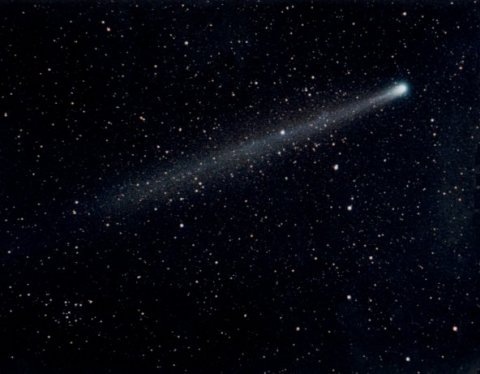Comets
Comets are essentially big dirty snowballs. They are mostly made of ice and dust and bits of rock.
They are about the size of cities and towns, sort of like frozen lakes in space.
There are probably about a billion comets in the outer reaches of the solar system, a region known as
the Oort Cloud.
Sometimes the orbit of a comet will be altered in a way that brings it into the inner solar system. When comets get close enough to the Sun, heat makes them start to evaporate. Jets of gas and dust form long tails that we can see from Earth. These tails can sometimes be millions of miles long. When the water and gas in a comet evaporates, it leaves behind a trail of gravel. If the Earth crosses the trail, we have a meteor shower as the bits of rock enter and burn up in our atmosphere. FAMOUS COMETS Halley - regular period of 76.1 years. Last pass in 1986. Next pass in 2061. Hale-Bopp - discovered in 1995 (seen before that in 2213 BC). Next pass in 4380 Hyakutake - bright and close in spring 1996. Next pass predicted between 72,000 and 116,000. Encke - Orbit of 3.3 years, Recent passes: December 2003, April 2007... West - a very bright comet. Seen in 1975-76. Broke into piece on last close approach of the Sun. COMET RECIPE Ingredients: Water, 2 cups Dirt, 2 heaping tablespoons Alcohol, 1 teaspoon Amino acids (sugar), 1 teaspoon Ammonia (non-detergent), 1 teaspoon Frozen - crushed, CO2, 1 pound Utensils: 6 quart mixing bowl 2 plastic shopping bags heavy pair of gloves hammer serving platter wooden spoon measuring cups and spoons Instructions: Line the mixing bowl with one of the plastic bags. Pour the water in the bowl. Add the dirt and mix with the spoon until uniform consistency is achieved. Add the three A's - alcohol, ammonia, amino acids. Put about a pound of dry ice in the other plastic bag (wear the gloves). Crush with the hammer until thoroughly powdered. Add the ice to the mixture and mix until it hardens. Compress it firmly (again the gloves) into a solid shape somewhere between a sphere and a potato. Serve on a platter, observe and discuss. |
